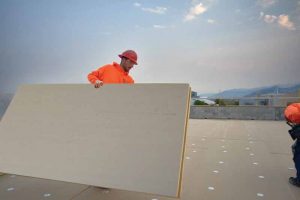
Prolonged service life and reusable properties
According to research published by Architecture 2030, the embodied carbon of a material is highest during its manufacturing process in most cases.3 The same studies have shown that in the first 30 years, embodied carbon can account for more than half of the emissions for a typical building and up to 80 percent of the emissions for a high-performance building. However, unlike most other construction materials, energy-saving products such as polyiso insulation offer the opportunity to recoup the product’s associated embodied carbon emissions by significantly reducing the environmental impacts of building operations. This is an important distinction for consideration in the early stages of a project’s design cycle when specifiers are considering how to prioritize carbon “budgets” for material selection.
Not only does polyiso reduce the carbon footprint by delivering improved thermal performance, but polyiso products can also be manufactured with raw materials that utilize recycled content (most commonly as part of the product’s facing materials). Building professionals may also seek opportunities to reduce environmental impacts through appropriate product reuse. While each building and project is unique, it may be possible to reuse polyiso roof insulation during a building’s roof replacement project. To help specifiers better understand the typical life cycle of a polyiso roofing products, the EPDs for polyiso roof insulation and HD cover boards assume the polyiso products will be replaced once during a building’s 75-year service life. This is typical industry practice and an important reminder for building practitioners to review the details
of other product EPDs that may not factor in a replacement cycle for the covered products.
Prioritizing energy-efficient building
Specifiers, architects, and construction professionals can consider using polyiso to meet stringent code requirements while enhancing a building’s energy efficiency and meeting sustainability goals.
Polyiso insulation is a material that supports new construction and retrofit upgrades and can be implemented across the building envelope to accommodate individual project needs. Aside from its high-performance properties, polyiso manufacturers are conscious of the material’s environmental impact and have a demonstrated history of reducing environmental impacts over time. By specifying polyiso, today’s industry professionals can deliver proven performance to any project—no matter its scope or the size of its sustainability aspirations.
Notes
1 See the building characteristics report, Commercial Buildings Energy Consumption Survey (CBECS), U.S. Energy Information Administration (EIA)
www.eia.gov/consumption/commercial/data/2018/pdf/CBECS_2018_Building_Characteristics_Flipbook.pdf.
2 For more details, see www.polyiso.org/page/EnergyCarbonSavingsAnalysis.
3 Refer to https://architecture2030.org/embodied-carbon-actions/ for more details.
 Author
Author
Justin Koscher is the president of the Polyisocyanurate Insulation Manufacturers Association (PIMA). In this role, he is the principle staff member for the board of directors and steering committee. His responsibilities include the implementation of the association’s strategic vision, management of finances and administration, and supervision of various PIMA work groups. Koscher joined PIMA in January 2017. He previously served as a director at the American Chemistry Council’s Center for the Polyurethanes Industry. He obtained his B.A. from Illinois Wesleyan University and J.D. from DePaul University College of Law.




